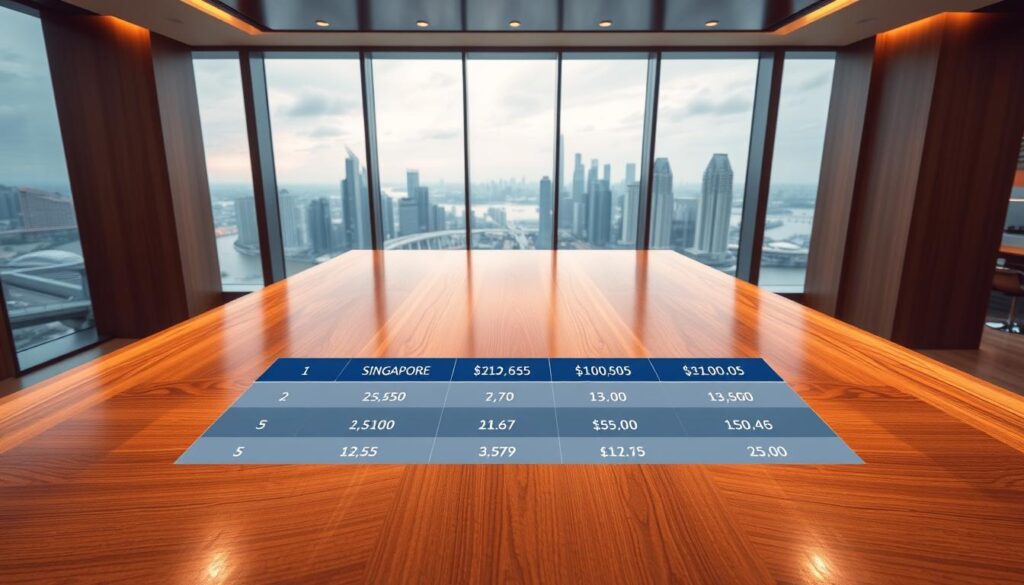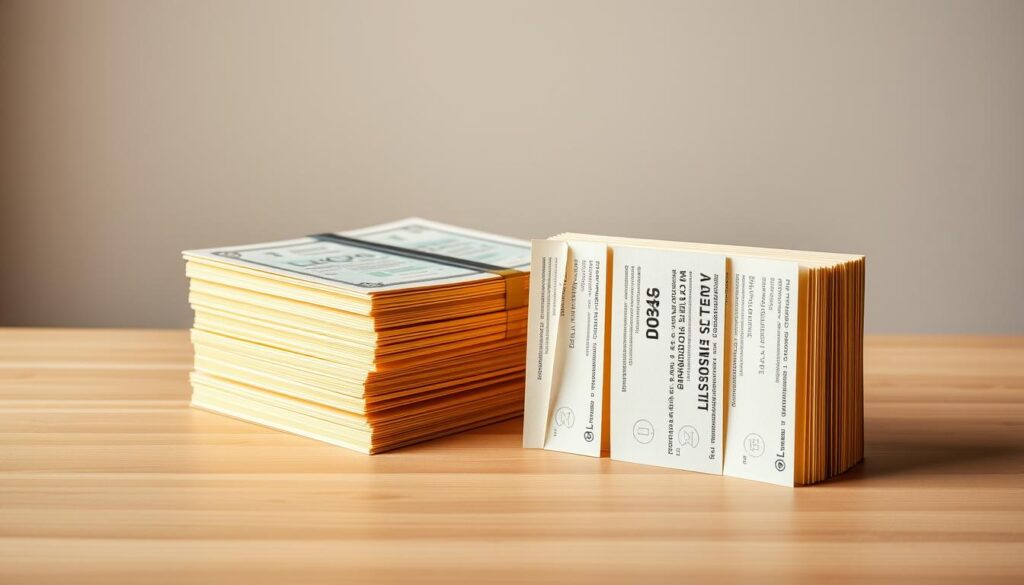Singapore’s financial market offers diverse opportunities to grow your savings. With competitive interest rates across banks, choosing the right fixed deposit can maximize your returns.
Local banks like DBS provide attractive time deposit options, while international players like SBI offer compelling short-term yields. Recent trends show 12-month tenures reaching up to 2.45% for standard accounts.
Digital platforms now make comparing bank offers easier than ever. Special promotions, including senior citizen bonuses, create additional earning potential for specific customer groups.
Key Takeaways
- 12-month fixed deposits currently yield up to 2.45%
- Digital platforms offer convenient rate comparisons
- Special promotions available for senior citizens
- Smaller deposits often get better percentage yields
- Alternative cash management accounts compete with traditional options
Current Trends in Singapore Deposit Rates
June 2025 brings mixed trends for those locking in funds with local banks. While some institutions trim offerings, others hold steady with competitive fixed deposit rates for specific tenures or customer segments.
Recent Changes in Fixed Deposit Rates
Major banks like UOB and OCBC reduced yields in June:
- OCBC’s online-only 9-month placement now offers 1.90%, down from 2.10% in May.
- UOB’s 6-month promotion for fresh funds sits at 2%, slightly above competitors.
Exceptions include SBI, maintaining 2.35% for deposits above S$50k.
“Banks are balancing liquidity needs with customer retention, leading to targeted promotions like ICBC’s 2.15% mobile-app exclusive.”
Why Deposit Rates Are Fluctuating
The Monetary Authority of Singapore’s (MAS) policies play a key role. With SGD interest rates trailing USD offerings, banks adjust to retain deposits. Global central bank trends further pressure local banking strategies.
For example, 6-month T-bills yield 2.20%, narrowly below top fixed deposit rates of 2.35%. This tight margin reflects broader market shifts.
Best Fixed Deposit Rates in Singapore (June 2025)
Short-term savers in June 2025 have several competitive options to consider. Whether you prefer 3, 6, or 12-month tenures, interest rates vary significantly across banks and promotions.

Top 3-Month Fixed Deposit Rates
*ICBC* and *CIMB* lead with 2.15% for 3-month placements, ideal for those seeking quick returns. *Bank of China* follows closely at 2.10%, but only via mobile app.
Minimum deposits range from S$500 (ICBC) to S$20k, making these accessible for smaller savers. Note: These are promotional rates requiring fresh funds.
Top 6-Month Fixed Deposit Rates
*SBI* dominates with 2.35% for deposits above S$50k, while *Citibank* offers 2.10% under similar terms. Smaller placements (S$10k) earn slightly lower yields.
“The 0.25% gap between top 6-month options highlights the value of comparing terms and conditions.”
Top 12-Month Fixed Deposit Rates
*DBS* stands out with 2.45% for 12-month locks, nearly 0.8% higher than *OCBC*’s branch rate (1.65%). This tenure suits savers prioritizing stability over liquidity.
Key differences:
- DBS requires S$10k, while OCBC accepts S$1k.
- Mobile-exclusive rates often outperform in-person offers.
Detailed Bank Comparisons for Best Deposit Rates Singapore
Choosing where to place your funds requires careful comparison of bank offerings. Each institution structures its deposit rate differently, with unique promotional rates and thresholds. Below, we break down key players to help you decide.
DBS and POSB Fixed Deposit Offers
DBS stands out with a tiered system. Placements between S$1k–19k earn 2.45%, while amounts above S$20k drop to 0.05%. This rewards smaller funds with higher yields.
POSB’s online banking portal simplifies applications. Both banks share the same terms conditions, including early withdrawal penalties.
SBI and ICBC Promotional Rates
SBI requires S$50k for its top 2.35% rate, ideal for larger investors. ICBC, meanwhile, adds 0.05% for mobile-app users with S$200k+ placements.
“Digital channels often unlock better rates—always check app-exclusive deals.”
Other Leading Banks: UOB, OCBC, and More
OCBC offers 1.90% online versus 1.65% at branches for 9-month locks. UOB’s 6-month placement hits 2%, but only for fresh funds.
- CIMB: 2.20% for 3-month tenures (preferred banking tier).
- Bank of China: 2.10% via mobile vs. 1.85% at counters.
Always verify deposit insurance coverage and currency options before committing.
Fixed Deposits vs. Savings Accounts
Flexibility or higher returns? The choice between savings accounts and fixed deposits depends on your goals. While fixed deposits offer locked-in interest rates, savings accounts provide easier access to funds. Below, we break down the key differences.

Interest Rate Comparisons
Savings accounts like UOB One offer up to 3.30%, outperforming their own 2% fixed deposit rates. However, these higher yields often require meeting conditions such as monthly spending or salary credits.
Fixed deposits, like DBS’s 7-month option at 2.30%, guarantee returns regardless of market fluctuations. This makes them ideal for risk-averse savers.
“Fixed deposits shine for predictability, while savings accounts reward active banking relationships.”
Liquidity and Flexibility
Need instant access? Savings accounts win. HSBC’s instant access accounts have no penalties, unlike their 1.40% fixed deposit with early withdrawal fees.
Minimum balances also differ. Many fixed deposits start at S$500, while premium savings accounts may require S$3k. Weigh these terms against your liquidity needs.
- Fixed deposits: Locked rates, penalties for early withdrawal.
- Savings accounts: Variable rates, bonus yields for meeting criteria.
Fixed Deposits vs. Singapore T-Bills
When choosing between fixed deposits and T-bills, investors face key trade-offs. Both offer secure ways to grow funds, but with different liquidity, protection, and yield structures.

The current 6-month T-bill yields 2.20%, slightly below top fixed deposit rates of 2.35%. However, treasury bills trade on secondary markets, while early withdrawals from fixed deposits incur penalties.
Risk and Return Profiles
T-bills carry direct government backing, making them virtually risk-free. Fixed deposits rely on bank stability but benefit from SDIC protection under the deposit insurance scheme.
Minimum investments differ significantly. You can start with S$500 for most fixed deposits, while T-bills require S$1k per auction. The auction system also means T-bill yields fluctuate weekly.
“T-bills suit those wanting government-grade security, while fixed deposits offer predictable returns with insurance coverage.”
Deposit Insurance Scheme Coverage
The Singapore Deposit Insurance Corporation (SDIC) protects fixed deposits up to S$100k per bank. This scheme doesn’t cover T-bills, though their government backing provides alternative security.
For 6-month tenures, both instruments compete directly. Fixed deposits lock in rates upfront, while T-bill yields finalize at auction. Consider your need for secondary market access versus guaranteed returns.
Key differences:
- Early withdrawal: T-bills allow secondary market sales
- Protection: SDIC covers deposits, MAS backs T-bills
- Minimums: S$500 vs S$1k entry points
Fixed Deposits vs. Singapore Savings Bonds (SSBs)
Investors weighing options between fixed deposits and Singapore Savings Bonds (SSBs) face distinct trade-offs. SSBs offer government-backed security, while fixed deposits provide locked-in returns. Your choice depends on liquidity needs, tenure, and risk tolerance.

Long-Term vs. Short-Term Returns
SSBs feature step-up interest rates over 10 years, starting at 2.20% for the first year. Fixed deposits, like DBS’s 12-month option at 2.45%, outperform short-term but require renewal risks.
Key differences:
- SSBs: Rates increase annually (e.g., 2.20% → 3.00% by year 10).
- Fixed deposits: Flat rates; reinvestment exposes you to future rate drops.
“SSBs hedge against rate declines, while fixed deposits capitalize on current highs.”
Minimum Investment Requirements
SSBs accept savings from S$500, ideal for small investors. Fixed deposits often start at S$1k–50k, with higher amounts needed for top-tier rates.
| Feature | SSBs | Fixed Deposits |
|---|---|---|
| Minimum Investment | S$500 | S$1k–50k |
| Redemption Timeline | 1-month notice | Maturity only (penalties apply) |
| Tax Implications | Tax-free | Taxable if exceeding S$20k |
SSBs also protect against inflation, as rates adjust with market trends. Fixed deposits lock in terms, which may lag behind rising rates.
Fixed Deposits vs. Cash Management Accounts
Cash management accounts (CMAs) present a modern alternative to traditional fixed deposits. These hybrid products combine features of savings and investment accounts, often offering higher yields than standard banking options.
Flexibility and Liquidity
CMAs like Syfe Cash+ process withdrawals in 1-3 days, unlike fixed deposits that lock funds for months. Fullerton’s SGD Cash Fund currently yields 2.41%, competing with top 12-month fixed deposit returns.
Key differences:
- CMAs allow partial withdrawals without penalties
- Fixed deposits guarantee rates but lack flexibility
- Professional managers handle CMA assets
“CMAs suit investors needing occasional access, while fixed deposits reward those who can wait.”
Risk and Insurance Coverage
Fixed deposits enjoy SDIC protection under the deposit insurance scheme, covering up to S$100k. Most CMAs lack this safeguard, though platforms like StashAway offer capital guarantees on select products.
Foreign currency CMAs introduce exchange rate risks absent in local fixed deposits. The Syfe Cash+ 3-month guarantee matches bank FD yields but without SDIC coverage.
Consider these factors:
- CMAs may invest in higher-risk instruments
- Fixed deposits provide predictable outcomes
- Foreign currency options require extra due diligence
Special Considerations for Priority Banking Customers
Priority banking customers enjoy exclusive perks that go beyond standard offerings. These premium accounts deliver enhanced deposit rates, personalized service, and integrated wealth solutions. The benefits often justify the higher placement amount requirements for qualified clients.
Higher Interest Rates for Priority Accounts
Banks typically offer 0.05%–0.15% boosts on promotional rates for priority clients. CIMB’s preferred tier earns 2.20% versus 2.15% for standard accounts on 3-month placements. RHB premier members access 2.10% yields unavailable to regular savers.
Key differences across banks:
- ICBC: +0.10% for placements above S$200k
- Standard Chartered: +0.15% at S$350k threshold
- DBS Treasures: Special 12-month rates at 2.50%
“Priority status transforms standard banking into a growth engine—our clients average 22% higher yields on cash holdings.”
Eligibility and Benefits
Qualification typically requires either assets under management (AUM) or monthly income thresholds. Most banks set minimums at S$200k AUM or S$15k monthly deposits. Some institutions like UOB accept insurance policies toward qualification.
The comprehensive benefits package often includes:
- Dedicated relationship managers
- Waived fees across multiple products
- Exclusive promotional rates on time deposits
- Seamless wealth management integration
Before upgrading, review all terms conditions. Some programs charge maintenance fees if balances fall below requirements. The cost-benefit analysis favors those maintaining consistent placement amounts above thresholds.
Conclusion
Smart savers know that locking in the right yield requires careful planning. For June 2025, fixed deposit leaders include DBS (2.45% for 12 months), SBI (2.35% for 6 months), and ICBC (2.15% for 3 months). Always weigh tenure, amount, and digital channel bonuses when comparing.
With interest rates potentially dipping later this year, consider diversifying across time deposit tenures or mixing FDs with SSBs and CMAs. Subscribe to Beansprout’s Telegram for real-time rate updates.
Final tip: Review banking terms thoroughly—early withdrawals often incur steep penalties. A balanced approach ensures your savings work efficiently across market cycles.



